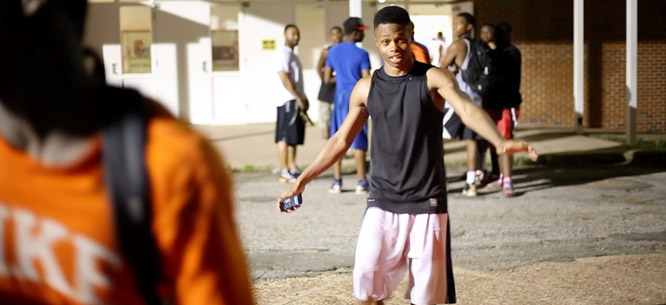
Still from Hale County This Morning, This Evening (Copyright IDIOM Film, Courtesy RaMell Ross)
In a year when two major studio films—BlacKkKlansman and Green Book—dominated debates about race and the movies, RaMell Ross’s extraordinary 2018 debut, Hale County This Morning, This Evening, can sometimes feel like it was made on another planet. Elusive, while those other movies played like blunt instruments; unsettling, while BlacKkKlansman and Green Book gave their respective audiences exactly what they paid for; Ross’s documentary about two young black men and the Southern county where they live moves to a different rhythm altogether. A photographer by training, Ross brings to his work an imagist’s appreciation for color, composition, and the “luminous detail,” producing a tone poem to a rural black experience we have grown accustomed to never seeing on screen. The result is an achingly beautiful portrait of everyday life—and one of the more compelling statements about race to come out of the movies in quite some time.
The film loosely follows two young men, Daniel Collins and Quincy Bryant, as they move through the final years of adolescence and into full adulthood. The lives they lead are utterly ordinary: Collins and Bryant go to school, hang out with friends, start families, go to work, watch television, endure tragedies large and small, dream of bigger things. But with time—and Hale County is constantly drawing our attention to the passage of time; Ross lets the camera keep running on a scene long after another director might have cut away, or suddenly speeds up or slows down the film in the middle of a shot—a more remarkable story begins to present itself. We live in a culture that is saturated with media representations of young black men like Collins and Bryant. And yet rarely are we granted the privilege of seeing their lives unfold as they do here—not as ciphers for all the dark fantasies of a racist social order, but as full inhabitants of their own prosaic and yet grand humanity.
Hale County This Morning, This Evening received a special jury prize at the 2018 Sundance Film Festival, was named Best Documentary at last year’s Gotham Independent Film Awards, and was nominated for the Academy Award for Best Documentary as well. Here, director RaMell Ross talks with Max Fraser about how and why he made Hale County, its unexpected success, and why the rural setting was ideal for a film about the “embeddedness of black folks in the American imaginary.”
Max Fraser: Films about African-American characters and communities—especially those that take place in the present rather than the historical past—rarely seem to adopt a rural framing. Why was that such an important story for you to tell with Hale County This Morning, This Evening?
RaMell Ross: Actually, I think about the film less as a story I set out to tell, and more as an experience of a place that I offer to an audience. It emerges directly from my own life experience: I moved to the “Black Belt”—Hale County, Alabama, specifically—to teach in 2009. As I recall, the impetus for picking up the camera and beginning to film the two main protagonists, Daniel and Quincy, came about from what I felt almost as a sadness—a sadness about the generalized inability to see communities like this one from the inside. And in the same way: where do these communities see themselves represented and celebrated in the world?
The film set out to just participate in the ebbs and flows of the place and its life, and reproduce that cinematically—which sounds wonderful, but was actually quite difficult to do, as slowness doesn’t translate readily to cinema. But slowness, to some degree, is a uniting element of rural life. People generally associate these kinds of places with simplicity, an impression that affects the way we think about all manner of life there, from the desires of the people to the daily activities that compose the communities. And then there is the specific historical baggage of slavery, which comes with the rural landscape—which the landscape itself forces us to contend with.
A lot of films about the black experience, at least superficially, want to avoid the connection between African Americans and this simplicity, and strive for settings that imply and overtly display a social dynamism. And that’s one reason why I wanted to engage. The Black Belt is the home of our social construction—it is from here that we are everything America has permitted us to be. There was no better place for innuendo, for subtlety, for inference; no better setting for presenting black folks in ways that are simultaneously basic and complex, historic and contemporary.

Fraser: Were you surprised by the critical reception the film received? I mean, I’m sure you were not counting on a jury prize at Sundance or an Oscar nomination—but did you expect the film’s relatively unusual representation of the black experience to resonate as strongly as it did with viewers?
Ross: It’s fascinating, right, that the “black banal” is unusual in popular, commercial representation? What a clear indication of a problem! Of course, the banal is naturally in opposition to the notion of entertainment, and it is through the representative strategies of the entertainment media that we’ve partly come to know what it means to be black or an African American.
I know the film is more than the black banal—but it does make a big break from the expected by avoiding the clarity and organization that narrative demands, by opting out of its built-in tyranny. No one on my team thought the film would do what it has. There are so many factors that go into a film being embraced. The timing for the type of inquiry Hale County is must have been perfect.
Fraser: So, why Hale County itself? What drew you initially to that location, and how did it provide the right setting for the film you were setting out to make?
Ross: The setting of the film, the people I met, my experience living there, was the inspiration for the film. I don’t believe I would have made this film—perhaps I would not have made a film at all—if not for the aleatory elements. I went by chance, tagging along with a friend, and my life circumstances encouraged me to stay and work in the community and live without rush and think and make.
Once there, something particular emerged through my photography practice—a way of looking that only the moving image could properly translate. I was obsessing over black representation and my casting within that paradigm, and at the same time building a relationship with Daniel and Quincy and with the community at large. All of this came together in a project in which I felt less like I was shooting a subject in a film, and more like I had found a new family in which I was a member.
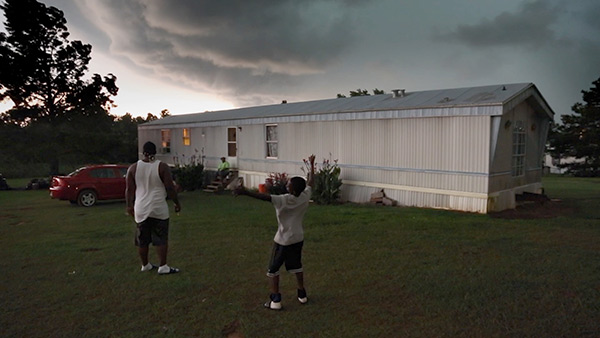
Fraser: Can you talk a bit about your work process? I have heard you say, for instance, that you gathered something like 1,300 hours of film, and yet what we end up seeing on screen is just seventy-six minutes long. The editing challenge alone must have been immense.
Ross: One of the project’s aims was to be there—to film, to live—in the lives of those shown longer than anyone else making a film would. When we consider the relationship between time and film, in terms of budgets and production schedules, it becomes obvious that meaning-making can become dependent on available resources; on how much time someone is willing and able to look and be present.
I think it’s especially true that, in the context of filming African-American communities, no one looks long enough for new meaning to emerge. Or to put it another way, with the necessary and urgent task of depicting and expressing the black community’s traumas, what is lost is everything else. So my process was simple: use time. And once the collection of unexpected events and images grew large enough, they began to speak to each other, in their form, their shapes and colors and sounds; and placing them beside each other began to create new meanings—meanings the isolated image couldn’t conjure on its own.
But isn’t this also how the mind works? It edits out most and then connects what is kept, to produce a narrative and determine what is reasonable and meaningful. We wanted to recreate that feeling, that dream logic—the whimsy of associative thinking in the context of fresh moments oozing with intimacy and the sensory.
Fraser: Given how much material you had to work with, how did you make decisions about what images to use? I can’t help but think of a line of text that appears early on in the film—“How do we not frame someone?”—which reads a bit like a tongue-in-cheek photography joke, and a bit like a meta-textual reflection on the editorial process itself. Why was “not framing” the characters you follow in Hale County so important to you?
Ross: From outside the brain trust of Maya Krinsky, Joslyn Barnes, and Robb Moss [all of whom contributed to editing Hale County], it might seem daunting or ultimately arbitrary which images and moments made the cut. But there was one stipulation for every image included in the film, before the final edit process: it had to lean heavily toward exceptional or unexpected beauty. Which we defined in many ways—conceptually, compositionally, and so on.
The entire endeavor of the film might be thought of as an attempt to not-frame a community and a people: to reflect a history of sinister framing while offering something else that still somehow touches the interiority of the viewer. The question is a bit quippish, an obvious legal pun, but I also meant it in earnest. Is there a mode of representation that allows for infinite possibility?
Maybe it doesn’t exist, and the act of representation itself necessarily denies infinity. But no one wants to be placed in the proverbial box. And in dealing with the images that have been applied to what it means to be black, the nearer the box built by decades of evolving iterations of racism, the closer to danger black folks find themselves.
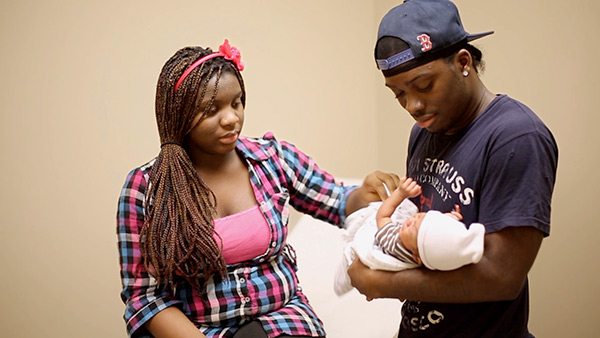
Fraser: Is that what you mean by “sinister framing”?
Ross: The African-American community’s image (while acknowledging the challenge of summing up such a wiggly thing) is a construction. An unavoidable one at this point. Racist and unknowing others in the past created and employed images to prove their beliefs of our inferiority, positioning us visually to confirm their fantasies of our hypersexuality. In many ways, photography and film have always been the technology of racism. They offered material proof of the racial lie.
Fraser: At the same time, there are visual cues interspersed throughout Hale County—of Daniel playing basketball, of endless fields of cotton, of flashing police lights—that immediately invoked for me the more familiar ways that black characters and especially black men have been framed in film or on television. Was that also an intentional move on your part?
Ross: Yeah, this idea, that Daniel’s and Quincy’s lives are ultimately composites of the big restless symbols of black life, is about the tension in our relationship to said symbols. Cotton is a mainstay fact and visual when trying to communicate African Americans’ ties to the South—but, is there a way to deploy that symbol that intensifies or contributes to its placement in the consciousness of contemporary culture? How do you illustrate honestly the role basketball plays in Daniel’s life, without resorting to the trope of the sport’s relationship to struggling individuals? Similarly, this abstract connection and stereotype pushed through news outlets and films—the connection between black people and guns—exists in tandem with the gun’s deep integration in American culture and the fact that black people, like all demographic groups, do own and brandish these weapons.
The power of the stereotype is its use. We wanted to stay on the periphery of these tropes, employ them wisely and in good faith, with the idea that reality grows in clarity when the symbols and other markers of meaning that determine how we imagine the world are made less obvious.
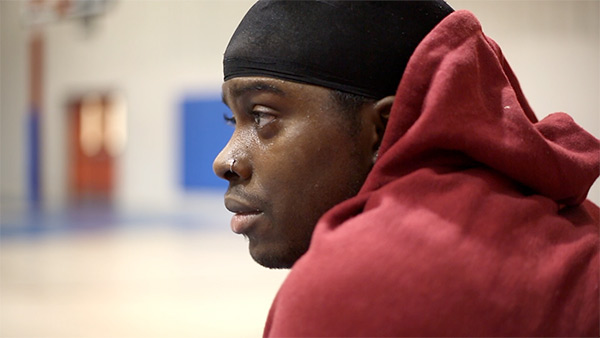
Fraser: What were your touchstones—cinematic or otherwise—in setting out to make a film like this? I feel like I can see the influence of a film essayist like Chris Marker; and I’ve heard you talk about James Agee’s weird, brilliant, exhaustive text for Let Us Now Praise Famous Men, the New Deal–era photojournalism project he collaborated on with the photographer Walker Evans (which, not incidentally, was also set in Hale County, Alabama). How did these or other figures or works of art shape your thinking about what you wanted to say with Hale County?
Ross: The film is a bit of Charles Burnett’s Killer of Sheep; a bit of Allen Ginsberg, Maya Deren, and Arthur Russell; a bit of Toni Morrison’s centralizing-the-black-gaze philosophy, Chris Marker’s gesturing of time, James Agee’s hyper-attentiveness—it’s drawing from a wide range of sources. There is even some Glenn Ligon in there. But, in fact, the film is pursuing the ineffable and uniting event of experience, human experience in the world, as a form of connection. Something more akin to music in its atmosphere, while channeling the bits that made the previously mentioned artists’ work alluring.
Fraser: Your film offers a perspective on everyday African-American life that will be unfamiliar to most viewers, but it also offers a portrayal of contemporary rural America that in a whole host of ways departs from stereotypical representations of who lives in these kinds of communities. Was that equally important to you as you were in the process of making this film—to refigure our thinking about rurality, just as you refigure our understanding of blackness?
Ross: Challenging notions of who lives in these communities was not a goal of mine from the outset of the film, though as I gathered footage it became clear that what was unfolding was in many respects an alternative depiction of this part of the country. The tight curation of the film contributed to this too, I think; you can see cuts where ideas about contemporary rural America and its inhabitants are reinforced.
A lot of it harks back to what I was saying about our awareness of how we deployed stereotypes in the film—that staying away from certain modes of representation in the context of black life by default brought forth alternative representations in other contexts. It was almost a domino effect of refiguring.
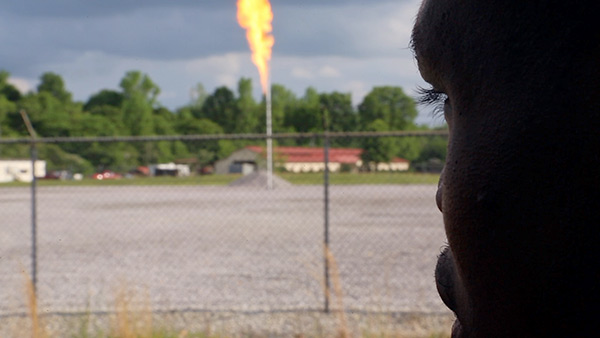
Fraser: So once you started self-consciously disrupting the familiar symbols that code the way we view and interpret the black experience, other, seemingly unrelated codes started breaking down almost as a matter of course. That suggests something pretty powerful about the centrality of blackness to the collective American symbolic vocabulary.
Ross: Yeah, it’s fascinating to consider. We don’t often truly consider the embeddedness of black folks in the American imaginary. America would not exist in its current form without the long history of the black experience, of course; and what that means, very viscerally, on the visual level, is almost impossible to consider. You can think hypothetically or romantically about living in another town or going to another school. But to consider how the symbolic associations tied to whiteness in America have meaning only because of the symbolic associations tied to blackness; how one set of cultural aesthetics are often created, consciously or not, in opposition to others; how the whole complex stew ultimately boils down to a single essential ingredient—well, it is a real down-the-rabbit-hole thought experiment.
Fraser: Do you think of Hale County as an explicitly, immediately political movie?
Ross: You know the footnote to Allen Ginsberg’s “Howl”? Replace “holy” with “political”: The world is political! The soul is political! The skin is political! The nose is political!
And so on.
Fraser: All right, fair enough. Let me try it a different way: is there a way in which we could think about Hale County as a movie about Trump’s America?
Ross: Perhaps. I’m not sure if it’s a leap. In what way do you think the film is about Trump’s America?
Fraser: Well, if the black banal is the tonal counterpoint to the entertainment industries’ idealizations of black life, it’s also the mirror image of the banalities latent in the injunction to “Make America Great Again.” To see Hale County—to follow its dream logic—is to be reminded that the dominant representative mode of a conservative rural America only holds if you don’t watch long enough for new meanings to emerge.
Ross: Well said, well said. And so, that representative mode continues to tell a story about a mythic America that has never been collective and inclusive. I hope it helps us see, however overwhelmingly, that these organizing principles of thought—these stereotypes—are where reality is invented and legislated from. And if not revealed for what they are, they will continue to produce new versions of the same old injustices.
RaMell Ross is a visual artist, photographer, and writer. He is an assistant professor in Brown University’s visual arts department.
Max Fraser is an assistant professor of American history at the University of Miami. He is currently a fellow at the Society of Fellows at Dartmouth College and is co-editor of “Left Paths in Rural America.”
Movements need ideas. And Dissent needs your support.
For sixty-five years and counting, readers like you have helped Dissent provide a vital, independent public forum for some of the most important voices on the left. Thank you for standing with us again in this critical year.
Donate now, or become a Solidarity Subscriber for $10 a month.


Spread the word